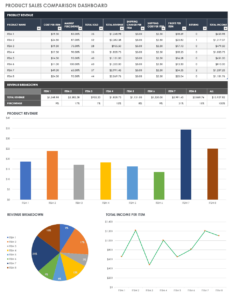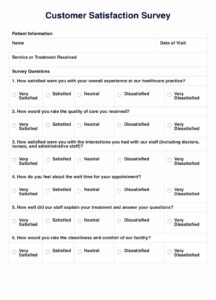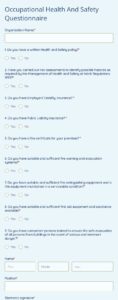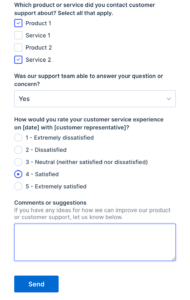Customer service survey templates offer several benefits, including:
- Standardization: Templates ensure that all customers are asked the same questions, allowing for easy comparison of results.
- Efficiency: Templates save time and effort by providing a pre-defined structure for surveys.
- Flexibility: Templates can be customized to meet the specific needs of a company or industry.
- Benchmarking: Templates facilitate benchmarking against industry standards or competitors.
- Actionable insights: The data collected from surveys can be used to identify trends, pinpoint areas for improvement, and make informed decisions.
When choosing a customer service survey template, it is important to consider the following factors:
- Target audience: The template should be designed to gather feedback from the relevant customer base.
- Survey goals: The template should align with the specific objectives of the survey.
- Length: The template should be concise enough to encourage completion while capturing the necessary information.
- Question types: The template should include a mix of question types, such as open-ended, closed-ended, and Likert scale questions.
- Analysis and reporting: The template should provide guidance on how to analyze and report the survey results.
Effective use of customer service survey templates can help businesses improve customer satisfaction, identify areas for improvement, and gain valuable insights into their customers’ needs and expectations.
Key Components of Customer Service Survey Template
An effective customer service survey template should include the following key components:
1: Introduction
The introduction should briefly explain the purpose of the survey and thank the customer for their time.
2: Survey Questions
The survey questions should be designed to gather specific feedback about the customer’s experience. A mix of question types, such as open-ended, closed-ended, and Likert scale questions, can be used to capture both qualitative and quantitative data.
3: Rating Scales
Rating scales allow customers to provide feedback on a specific aspect of their experience, such as satisfaction, likelihood to recommend, or ease of use. Common rating scales include 5-point Likert scales and star ratings.
4: Open-Ended Questions
Open-ended questions give customers the opportunity to provide detailed feedback in their own words. These questions can be used to gather insights into the customer’s experience and identify areas for improvement.
5: Demographic Questions
Demographic questions collect information about the customer’s age, gender, location, and other relevant characteristics. This information can be used to segment the survey results and identify trends within specific customer groups.
6: Call to Action
The call to action should encourage the customer to complete the survey and provide their feedback. This can be done by offering an incentive, such as a discount or entry into a drawing, or simply by expressing appreciation for their participation.
Summary
An effective customer service survey template should be comprehensive, easy to understand, and relevant to the specific needs of the business. By including the key components outlined above, businesses can gather valuable feedback from their customers and use it to improve their products, services, and overall customer experience.
How to Create a Customer Service Survey Template
Creating a customer service survey template is a valuable step for businesses looking to gather feedback and improve their customer experience. Here are the steps involved in creating an effective template:
1: Define the Purpose of the Survey
Clearly define the goals of the survey. What specific feedback do you need from customers? Are you looking to measure satisfaction, identify areas for improvement, or track progress over time?
2: Identify the Target Audience
Determine who you want to receive the survey. Is it all customers, a specific segment of customers, or customers who have recently made a purchase?
3: Choose the Right Survey Questions
Select a mix of question types, including open-ended questions to gather qualitative feedback and closed-ended questions to gather quantitative data. Use a combination of rating scales, Likert scales, and demographic questions to capture a comprehensive range of feedback.
4: Design the Survey Template
Use a survey tool or software to create the survey template. Include clear instructions, avoid jargon, and keep the survey concise and easy to complete.
5: Test the Survey
Before launching the survey, test it with a small group of users to ensure it is clear, user-friendly, and meets your objectives.
6: Distribute the Survey
Choose the appropriate distribution channels for your target audience. Consider email, social media, or embedding the survey on your website.
7: Analyze the Results
Once you have collected responses, analyze the data to identify trends, areas for improvement, and actionable insights.
Summary
Creating a customer service survey template is a crucial step for businesses looking to gather valuable feedback from their customers. By following these steps and carefully considering the purpose, target audience, and survey design, you can create an effective template that will provide insights to improve your products, services, and overall customer experience.
Customer service survey templates are a valuable tool for businesses looking to gather feedback and improve their customer experience. By providing a structured framework for collecting customer feedback, businesses can identify areas for improvement, track progress over time, and gain valuable insights into their customers’ needs and expectations.
An effective customer service survey template should include key components such as an introduction, survey questions, rating scales, open-ended questions, demographic questions, and a call to action. When creating a survey template, it is important to define the purpose of the survey, identify the target audience, choose the right survey questions, design the survey template, test the survey, and distribute the survey.
By following these steps and carefully considering the purpose, target audience, and survey design, businesses can create an effective customer service survey template that will provide valuable feedback to improve their products, services, and overall customer experience.



